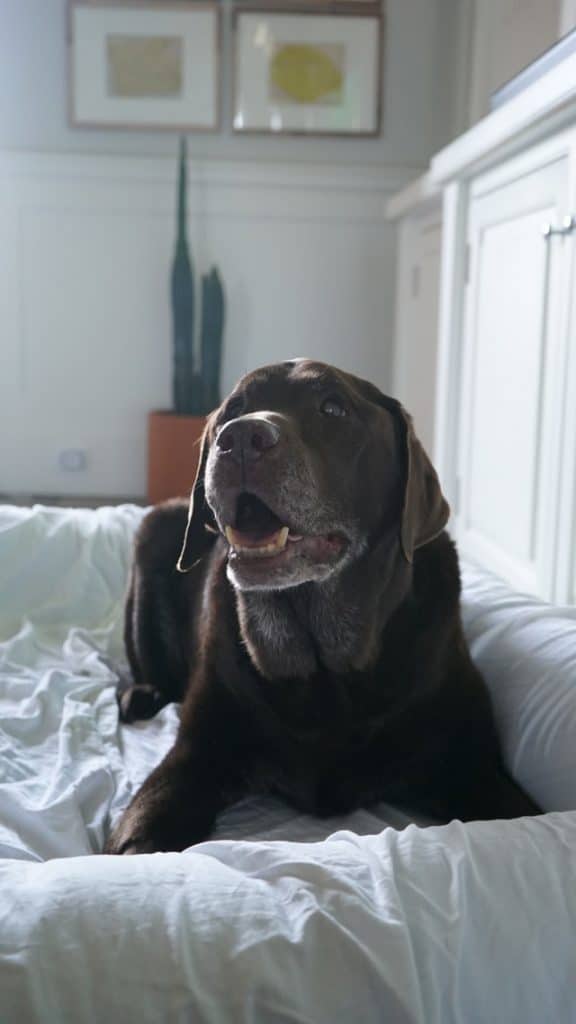
Your dog is your best friend, and you only want the absolute best for him. It’s the same for all good doggy parents, and that’s why you’re reading this blog. So, maybe your Rover is a bit older, or perhaps he had an injury or suffered from some genetic condition. Either way, he’s having trouble getting out of bed, but once he’s up, he seems just fine and dandy. So, you’re wondering what could cause the perplexing situation. I mean, surely he’s not faking it, right?
In this article, we unpack some common causes of your pooch having trouble getting up, but then walking fine.
Hip Dysplasia
Hip dysplasia is common in larger dog breeds, so if your snuggle bug is a mastiff or St Bernard, look out for the tell-tale signs. If your little fur kid is a small breed, you’re not necessarily off the hook, though, since some of them can get it too. Generally, you can recognize this inherited condition when your dog seems stiff and has trouble getting up when he’s lying down. Mr Schnoocums might also be hesitant to climb stairs or stand on his hind legs. Take him to the vet for a proper examination if you’re not sure.
So, what is hip dysplasia, anyway? Dogs with this condition have improperly formed hip joints. This means that the leg bone moves around too much because the joint is loose. Kind of like a key that doesn’t quite fit the lock it’s intended for. This could potentially cause some awful pain for your poor fur kid, which gets worse over time. Some cases are so mild that you won’t even notice, while others are severe and require your vet’s intervention (https://pets.webmd.com/dogs/canine-hip-dysplasia#1).
This condition shows up at any age, even when your pooch is still a puppy. Unfortunately, there’s nothing you can do to prevent it because it’s inherited. You can manage the effect, though, through targeted exercise, a healthy diet, keeping your pooch warm and dry when he sleeps, and, in extreme cases, some special meds. Activity that generally helps these poor pups include swimming. Swimming strengthens the hip joint muscles, giving him a fighting chance at a healthy doggy life.
Arthritis
Yikes, it affects animals too! Arthritis isn’t uncommon in dogs that are a bit more advanced in years. One of the tell-tale signs of arthritis in dogs is when they have a hard time getting up but then walks around just fine. You know, like “please don’t make me get out of bed! It will end my world!” with those sad puppy eyes making your heart melt. They’ll whimper and whine, and have the worst time getting up. And then, the moment they’re up, they’re going around their business like nothing ever happened.
Arthritis is joint pain, caused by inflammation in the joints. Unfortunately, this condition gets worse over time and has some pretty adverse effects on your doggo’s quality of life and mobility – more on that here: https://www.whole-dog-journal.com/health/natural-dog-arthritis-treatments/
As with most doggy diseases, overweight dogs suffer more than their healthy cousins. Here, the extra weight they’re carrying around could really make things a lot worse, so that’s one more reason to keep your pup at a healthy weight.
Some common symptoms of arthritis include changes in gait and generally being uncomfortable. They would probably have trouble lying down as well – you’ll hear those grunts and see them fidget as they try, and fail, to get comfy. If the arthritis is causing some pain, you’ll see your pooch licking his legs or paws, and he might be limping, even before exercise. Speaking of which, he’d be hella stiff after a walk and probably won’t want to jump either. Poor fur kid.
While you can’t cure arthritis, you can manage the condition. Your vet might prescribe some meds and supplements to help keep your pup comfortable. It’s also a good idea to maintain regular exercise. However, you might want to do multiple short walks instead of one really long one. You know, go just far enough to get the blood pumping and tail wagging, but not so far that he’ll get stiff. If he’s telling you that something hurts, stop what you’re doing and try something else tomorrow, or whenever he’s ready.
In extreme cases, you could opt for laser therapy of one of a myriad of mobility tools, such as slings, rear-end harnesses, wheelchairs, and carts. These help your pooch stay active without taking such a crazy toll on his body.
You might want to make some changes around the house too. If your floors are slippery, put down some non-slip pads to prevent Coco from having a slip. Also, put down some ramps, or help her get up and down the stairs or couch. Make sure her bed is soft and comfy, and warm! Cold weather makes arthritis worse, so keep the heater on if you need to.
Back Leg Weakness
Back Leg Weakness is a common name for the inherited Degenerative Myelopathy (DM) disease. Here, the protective layer around your dog’s spinal cord degenerates, exposing the nerve fibres. Sine this disrupts communication in the body, your dog’s hindquarters gets weaker, and could eventually even become paralyzed (https://wagwalking.com/condition/back-leg-weakness). Yikes!
Many symptoms indicate Back Leg Weakness, and many of them overlap with other conditions. So, if you see some of these, especially if they get worse over time, take your pooch to the vet for a proper check-up. Some symptoms include lameness, lack of coordination, loss of balance, a staggering gait, difficulty standing up, reluctance to exercise, pain, incontinence, swelling, weight gain, and loss of muscle mass. These are all pretty scary.
The good news is that this condition is treatable. Your vet might recommend surgery, and will probably prescribe some pain meds too. During recovery, it’s important to keep Fido’s weight under control, so a strict diet might be necessary. Regular exercise – whatever they’re comfortably capable of at the time – is essential to keep them mobile and fit. This will also help to prevent unnecessary weight gain.
Muscle Atrophy
Muscle atrophy is literally the wasting away of your dog’s muscles. All dog breeds are susceptible to this condition (https://www.gwfnutrition.com/post/2018/08/22/how-to-spot-muscle-atrophy-in-dogs).
One tell-tale sign of this condition is that your pooch’s muscles are getting thinner. For instance, you can suddenly close your hand around their thigh, when it used to be too big for that. They could also be losing weight – you might not be in the habit of regularly weighing your dog. Still, you’ll probably notice that he’s feeling a bit lighter than usual when you pick him up.
Another common symptom of muscle atrophy is physical weakness. So, your dog might have trouble getting up, or prefer to use his front legs rather than his hind legs. Coco might also be in pain, or a bit sluggish, which is all part of the overarching problem.
Since muscle atrophy has many possible causes, the treatment, and treatability, would also vary widely. It’s best to see your vet as soon as you can and have your fur kids checked out. Regular exercise would probably be part of the treatment, regardless of the cause. We all need a decent workout, and our fur kids are no exception. The next step is diet: your vet will probably prescribe some protein supplements along with a healthy diet, to give you pooch all the goodies he needs to recover.
Overgrown Nails
Say what now? If your pup has long nails, it might dig into their paws, especially when they’re getting up. Since this is painful, they might take a long time getting up, and possibly even whimper or whine along the way. Overgrown nails only affect a dog’s gait in severe cases.
Luckily, this one is super easy to treat. Just trim those nails! Before you dig in with a clipper, though, there are some things you need to know. When your pooch’s nails grow super long, the quick also becomes longer. That’s the part with blood vessels and nerve endings, so it’s essential not to nip that while you’re trimming. Luckily, if you do it right, you can make the quick recede over time (https://pethelpful.com/dogs/How-to-Make-a-Dogs-Quick-Recede), returning your pup’s paws to normal and having them jump for joy. The key here is to trim your pooch’s nails a little bit at a time, about once every four days. If they don’t like getting their nails trimmed, do some sensitivity training with whatever tool you choose – they’ll get used to it in no time. There are also a ton of different nail trimming tools available on the market, so with a bit of research, you can find the one that floats your boat and puts your pup at ease.
In Closing
There are a whole heap of potential causes for your dog to have trouble getting up, but then walking fine and even running without any problem. Some of them are curable, while others can only be managed with the correct treatment. Either way, if your dog is showing some symptoms, it’s best to whisk him off to the vet for a proper check-up. That way, you can catch whatever the cause is, early, and get the appropriate treatment underway in no time.






